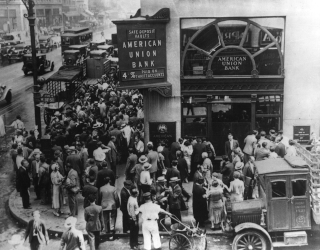The Crown Retail Deposit Guarantee Scheme was an opt-in deposit insurance scheme, established under the Public Finance Act 1989 in New Zealand during the Great Recession, 2008 to 2011. Dr Michael Cullen, Finance Minister at the time of the scheme's introduction said, "The deposit guarantee is designed to give assurance to New Zealand depositors. The New Zealand banking system remains sound. We want to ensure that ordinary New Zealanders feel that their deposits are safe in the current uncertain international financial market conditions." [1]

Deposit insurance is a measure implemented in many countries to protect bank depositors, in full or in part, from losses caused by a bank's inability to pay its debts when due. Deposit insurance systems are one component of a financial system safety net that promotes financial stability.

The Great Recession was a period of general economic decline (recession) observed in world markets during the late 2000s and early 2010s. The scale and timing of the recession varied from country to country. The International Monetary Fund (IMF) has concluded that it was the most severe economic and financial meltdown since the Great Depression and it is often regarded as the second worst downturn of all time.

Sir Michael John Cullen is a former New Zealand politician. He served as Deputy Prime Minister of New Zealand, also Minister of Finance, Minister of Tertiary Education, and Attorney-General. He was the Deputy Leader of the Labour Party from 1996 until November 2008, when he resigned following a defeat in the general election. He resigned from Parliament in April 2009, to become the deputy chairman of New Zealand Post from 1 November 2009 and chairman from 1 November 2010.
Contents
The scheme guaranteed that the New Zealand Government would repay those who lost money in failed financial institutions. It was implemented on 12 October 2008, administered by Treasury and the Reserve Bank and at its height resulted in Crown guarantees over $133 billion. [2] Ninety-six institutions were covered by the scheme - 60 non-bank deposit takers, 12 banks and 24 collective investment schemes. All guarantees had ended by December 2011. [3]

The Government of New Zealand, or New Zealand Government, is the administrative complex through which authority is exercised in New Zealand. As in most parliamentary democracies, the term "Government" refers chiefly to the executive branch, and more specifically to the collective ministry directing the executive. Based on the principle of responsible government, it operates within the framework that "the Queen reigns, but the government rules, so long as it has the support of the House of Representatives". The Cabinet Manual describes the main laws, rules and conventions affecting the conduct and operation of the Government.

The New Zealand Treasury is the central public service department of New Zealand charged with advising the Government on economic policy, assisting with improving the performance of New Zealand's economy, and managing financial resources.

The Reserve Bank of New Zealand is the central bank of New Zealand. It was established in 1934 and is constituted under the Reserve Bank of New Zealand Act 1989. The Governor of the Reserve Bank is responsible for New Zealand's currency and operating monetary policy. The Bank's current Governor is Adrian Orr. Employees of the bank operate under the framework of a managerial hierarchy.







